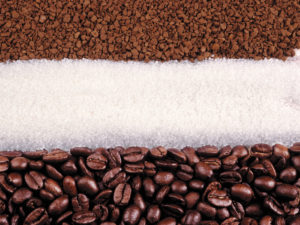 Soft futures were mixed on Tuesday with sugar, cotton and cocoa gaining, while robusta and arabica posted declines.
Soft futures were mixed on Tuesday with sugar, cotton and cocoa gaining, while robusta and arabica posted declines.
On the ICE Futures U.S. Exchange, arabica coffee for September delivery traded at $1.2403 a pound at 13:15 GMT, down 0.82% on the day. The C contract settled 1.8% higher on Monday and extended last weeks 3.08% advance as temperatures below zero in some of Brazils growing areas threatened to damage the crop. Futures swung between gains and losses on Tuesday, hitting a days high at $1.2648 a pound, after which a round of profit taking kicked in, causing prices to plunge.
Weather forecaster Somar Meteorologia said in a report yesterday that a polar air mass will reach the state of Parana early tomorrow and minimum temperatures will fall as low as minus 1 degree Celsius. However, the weather agency reported that lower temperatures will leave trees undamaged in Sao Paulo and Minas Gerais, the largest arabica-producing state. Paranas output is expected to total 1.7 million bags of coffee in the 2013-2014 season. Total output in Brazil is expected to stand at 48.6 million bags. Sao Paulo is set to produce 12.6 million bags of coffee, whereas Minas Geraiss output will most likely equal 25.5 million.
Sterling Smith, a futures specialist at Citigroup Inc., said in a report yesterday: “All eyes are on the Brazilian weather and whether or not we see some degree of crop damage from the cold snap expected mid-week. Forecasts are looking for cold, but extremely limited, if any, crop damage.”
Meanwhile on the NYSE Liffe in London, robusta coffee for September delivery marked a 1.44% daily decline, trading at $1 917 a ton at 13:18 GMT. Prices ranged between days high and low of $1 960 and $1 915 a ton respectively. The September contract settled 1.2% lower yesterday, extending current weeks decline to over 2.5% so far after advancing 5.02% the preceding one.
Elsewhere on the market, cocoa for September delivery traded at GBP1 598 a ton at 13:19 GMT, up 0.38% on the day. Prices held in range between GBP1 608 and GBP1 592 a ton respectively. Cocoa for the same delivery month surged to $2 359.50 a ton at 13:19 GMT in New York, marking a 0.64% daily gain. Prices varied between days high and low of $2 373.50 and $2 341.50 a ton.
Sugar gains
Meanwhile, sugar advanced amid estimates by the London-based International Sugar Organization that global output will drop by 1.8% to 178.5 million tons in the marketing year that starts October, while demand is expected to rise by 1.9% to 175 million tons.
On the ICE Futures U.S. Exchange, sugar for October delivery traded at $0.1647 a pound at 13:20 GMT, up 0.52% on the day. Prices held in range between days high and low of $0.1654 and $0.1634 a pound respectively. The sweetener advanced through the four past days and is so far marking a 1.1% weekly gain after closing 1.31% higher last week.
According to a Bloomberg survey, sugar prices will increase by as much as 13% to $0.185 by March, the end of the season in Brazil. After reaching a three-decade high in 2011, the sweetener has fallen 54% so far as growers throughout the world raised output to meet demand. This year alone, raw sugar fell 16% to $0.1643 a pound on the ICE U.S. and has become the second-worst performing commodity in the Standard & Poor’s GSCI Index of 24 raw materials.
However, due to the bearish market, many countries reduced their cane acreage in the recent past, raising concern over supply. Leonardo Bichara Rocha, a senior economist at the International Sugar Organization, said farmers in India, Russia and the European Union have reduced their acreage. The group expects the sugar surplus to narrow to 3.5 million tons next season, down from a record 10 million.
Abah Ofon, a Singapore-based analyst at Standard Chartered Plc., said for Bloomberg: “The surplus is not going to last forever. There’s less incentive to increase production. We’ll see a drop in supply.” He predicts sugar to reach an average of $0.200 a pound in the first quarter.
According to Thai Sugar Millers Corp., Thailand, the largest exporter after Brazil, is expected to boost its output by 10% to 11 million tons in the year that begins in November. Shipments may jump by as much as 6.7% to 8 million tons, exceeding projections for 8 million. Meanwhile according to data compiled by Bloomberg, India, the second largest producer after Brazil, is expected to produce 23.5 million tons in the next season, 1.5 million tons less. According to the USDA, Chinese growers will reduce cane acreage by 2% to 4.32 million acres. In the same time, output in the U.S., the third largest importer, will fall by 4.1% to 7.84 million tons. According to Brazilian industry group Datagro Ltd., millers in Brazils main growing region, the center-south, will use more cane for ethanol production this year instead of sugar as rains reduced the crops potential to yield sugar. Millers will use 53.8% of the cane crop to produce ethanol, up from the previous estimate of 52.6%.
Cotton fairly unchanged
Meanwhile on the ICE Futures U.S. Exchange, cotton remained fairly unchanged on the day after swinging between gains and losses. Cotton for December delivery traded at $0.8629 a pound at 13:21 GMT, up 0.11% on the day. Prices ranged between days high and low of $0.8650 and $0.8604 a pound respectively. The fiber surged more than 0.3% on Monday, bringing the current weeks advance to 0.3% after settling 1.03% higher the previous one.
In its weekly crop progress report on Monday, the USDA said cotton squaring advanced last week but still fell behind last years pace. As of July 21, 77% of the crop was squared, compared to 68% a week earlier. This was below last years 88% during the comparable 7-day period and the five year average reading of 83%.
As for the cotton condition, the agency reported it was overall a bit worse than last years and fairly unchanged compared to the preceding week. As of July 21, 24% of the crop was categorized as “Very poor” and “Poor”, compared to 26% a week earlier and 18% in 2012. Meanwhile, 32% of the cotton fell in the “Fair” category, the same like the previous week but less than the preceding seasons 35%. As for the premium quality, 44% was rated good-excellent, above the previous weeks 42% but below 2012s 47%.





